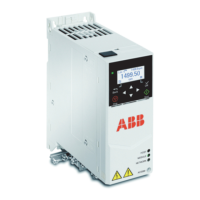246 Parameters
43
43 Brake chopper
Settings for the internal brake chopper.
43.01 Braking resistor
temperature
Displays the estimated temperature of the brake resistor,
or how close the brake resistor is to being too hot.
The value is given in percent where 100% is the eventual
temperature the resistor would reach when loaded long
enough with its rated maximum load capacity (43.09
Brake resistor Pmax cont).
The temperature calculation is based on the values of
parameters 43.08, 43.09 and 43.10, and on the
assumption that the resistor is installed as instructed by
the manufacturer (ie, it cools down as expected).
-
0.0…120.0% Estimated brake resistor temperature. 1 = 1%
43.06 Brake chopper enable Enables brake chopper control and selects the brake
resistor overload protection method (calculation or
measurement).
Note: Before enabling brake chopper control, ensure that
• a brake resistor is connected
• overvoltage control is switched off (parameter 30.30
Overvoltage control)
• the supply voltage range (parameter 95.01 Supply
voltage) has been selected correctly.
Disabled
Disabled Brake chopper control disabled. 0
Enabled with thermal
model
Brake chopper control enabled with the brake resistor
protection based on the thermal model. If you select this,
you must also specify the values needed by the model, ie.
parameters 43.08, and 43.09, 43.10, 43.11 and 43.12.
See the resistor manufacturer data sheet.
1
Enabled without
thermal model
Brake chopper control enabled without resistor overload
protection based on the thermal model if the resistor is
equipped with a thermal switch that is wired to open the
main contactor of the drive if the resistor overheats.
For more information, see chapter Resistor braking in the
hardware manual.
2
Overvoltage peak
protection
Brake chopper control enabled in an overvoltage
condition.
This setting is intended for situations where
• the braking chopper is not needed for runtime
operation, ie. to dissipate the inertial energy of the
motor,
• the motor is able to store a considerable amount
magnetic energy in its windings, and
• the motor might, deliberately or inadvertently, be
stopped by coasting.
In such a situation, the motor would potentially discharge
enough magnetic energy towards the drive to cause
damage. To protect the drive, the brake chopper can be
used with a small resistor dimensioned merely to handle
the magnetic energy (not the inertial energy) of the motor.
With this setting, the brake chopper is activated only
whenever the DC voltage exceeds the overvoltage limit.
During normal use, the brake chopper is not operating.
3
No. Name/Value Description Default
FbEq 16

